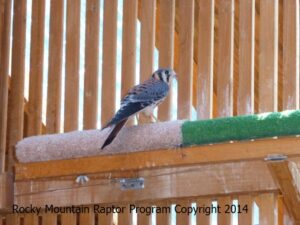*UPDATE*
The young male American Kestrel that was admitted on 6/26 with severe spinal trauma, was moved this past weekend to a small conditioning enclosure in our flight complex.
This tough little man has rallied to overcome most of the deficits to his legs/feet and now shows excellent flight, maneuverability and improving landings.
His road has been a challenging one. The first big challenge faced by spinal trauma raptors is being able to properly evacuate waste (poop) from their bodies. A large part of the process is mechanical. The inability to stand and compromised muscle use makes this very difficult. If the waste accumulates or is only cleared a little at a time, the solid waste will harden in to a rock like mass that will further impede waste evacuation. The birds body will quickly go septic if the waste persists too long. If the bird doesn’t poop,then you can’t feed it. It’s a vicious cycle.
We keep these birds well hydrated with subcutaneous fluids, give them pain medications to make it comfortable in order to to stabilize the bird and begin the healing process.We will also homeopathics to help assist the body in healing. Once the bird is eating and pooping regularly and we feel the healing process is well under way, we will then begin physical therapy on the affected limbs. Passive range of motion is a standard therapy that we use that involves gentle massage and manipulation of a wing or leg to encourage the bird in using the wing or leg (feet) and hopefully return it to normal use.
While he still has a way to go, hopefully this bird will be ready for live prey testing soon and then get his Second Chance at Freedom!
